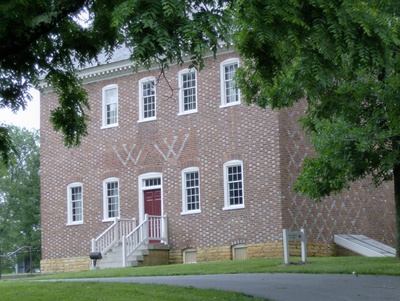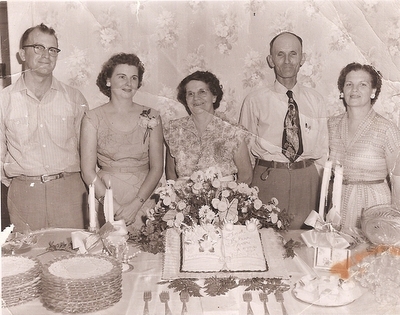The parents
of Goldman Davidson Castle were William Castle (1799-1859) and Margaret Cox
(1799-1880). Siblings of G.D. Castle
were James, John, Sarah, William Henderson, Margaret, Henry, George Harvey, and
Patton Robert. Sometime after the birth
of their children, William and Margaret moved to Pulaski County, Kentucky, and
then to Morgan County, in a large migration of Castles, Days, Salyers, and
others from the Copper Creek area of southwestern Virginia. Goldman
Davidson is thought to have been named for men with those surnames that his
parents knew in Virginia. William’s parents
were Jacob Castle, Jr. (1749-1849—yes, 100 years!) and Mary Shane.
My cousin
Fred Castle, son of my grandmother’s youngest brother Tom, was the Castle
historian. He made several trips to
Kentucky and southwest Virginia trying to tie our Castles to the families of
Castlewood, Virginia. I remember when he
first had contact with Castle family members that still lived in Castlewood, and
how excited he was when he felt he could finally prove our descent, through
William Castle, from Jacob Castle, “the Longhunter.”
Jacob Castle
Sr. was quite a character, and if Castle family researchers are correct in
naming Peter Cassel as his father, he came from quite a family. Peter Cassel was the son of Johannes Cassel,
a Mennonite who came on the ship Jeffries
to Philadelphia in 1682 after attending a meeting in Kriesham, Germany, in
which William Penn himself spoke to the audience about religious freedom and
the land that was available in America.
Johannes became one of the signers of the Germantown, Pennsylvania
charter.
Jacob took a
different path—he went native. His first
wife was Shawnee; her name Sowege means “gliding swan.” They married about 1736, and she was the
mother of Jacob Jr. and perhaps others.
Jacob may have had several other wives, reputedly all Cherokee, with
whom he had other children. He came to
southwest Virginia when it was the frontier, and apparently traded with the
natives for land that became known as “Castle’s woods.” Because his name had been associated with the
area long before Daniel Boone set foot there, it has been suggested that old
Jacob may have been the one who pointed out the Cumberland Gap to Boone.
Jacob’s
Indian name was “White Tassel,” and some have even gone so far as to describe
him as an albino. It is more probable
that, with his German heritage, he was very fair-haired compared to his Indian
neighbors. As a longhunter, he would
have ranged far from home, killing deer for meat and hides with his long-barreled
rifle made by German gunsmiths in Pennsylvania.
He would have lived much as the Indians did. In my mind, I see him as a blonde Daniel
Day-Lewis in The Last of the Mohicans.
For this next
part I am indebted to Mitchell Farish, a librarian at the University of
Virginia, who has a great website with the title “Birth of American Frontier
Culture.” He put historical documents
and traditions concerning Jacob Castle into a context that finally made sense
to me.
In 1740
Jacob bought land on the New River from Jacob Stover. When he was home from his travels, he seemed
to have conflicts with his neighbors, particularly one named Adam Herman (or
Harmon.) In 1746 Jacob and other
settlers were detailed to build a road from Adam Harmon’s to the river; Jacob
objected. In April 1749 Herman’s home
was robbed of several deer and elk skins on three consecutive days. Jacob became a suspect since he hunted with a
party of Indians that had been known to steal horses and other livestock in the
settlement. Herman applied for a writ to
arrest Jacob Castle and led a posse to Jacob’s hunting camp in Castle’s woods,
but Jacob’s Indian friends chased the posse away. Later in the month Adam and his brother were
arrested because they had robbed Jacob.
By May 17 Adam was out of jail, charging Jacob with “threatening to aid
and assist the French against his Majesty’s forces.” Jacob was arrested, tried, and acquitted of
the charge of treason.
Others have
commented that Jacob probably did feel more loyalty to his Indian friends—and
thus the French—than he did to the British.
I would like to think so, since my sympathies have always been with the
Indians. (Wait till you hear about my
ancestor on the other side of the family, William Whitley. He and Jacob Castle are my only claims to
famous ancestors, and they couldn’t have been more different.) In any case, Jacob was thought to have taken
part in the Battle of Kings Mountain in the Revolutionary War—with the
Americans.
My
cousin Fred died several years ago, but I was pleased to recently find this
post of his from a genealogy message board about the eventual resting place of
Jacob Castle: “What
an experience it was to visit the area where the old Jacob Castle was
supposedly buried on a hill near a plot of land still called Castle's meadow,
uphill from Copper Creek.” It makes me
think of the poem by Robert Louis Stevenson:
Home is the sailor, home from sea,
And the hunter home from the hill.




































